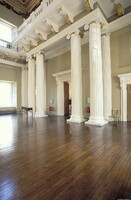Banqueting House
Jones, Inigo; Rubens, Peter Paul

Download1A1-JI-BH-E5_cp.jpg (486.4Kb)
Alternative Title
Banqueting House, Whitehall
Date
1619-1622Description
The Great Room, side view of the entry on the north wall; The concept of a projecting centre flanked by simpler, recessed bays, which is characteristic of Palladio's work, appears in several other contemporary designs by Jones. An example of this type of façade composition is Jones's Banqueting House (1619-1622), Whitehall, London, which was intended to be used for royal entertainments and masques. This building, Jones's most important work, is planned as a simple rectangular hall proportioned as a double cube. The elevations are designed in two main storeys with superimposed orders - Ionic and Corinthian - above a rusticated base. Both long sides have their three central bays emphasized by engaged columns, with pilasters articulating the outer bays. The orders are classically detailed, with entasis (swelling) in the columns and a pulvinate (convex) Ionic frieze. Early designs for the Banqueting House (Chatsworth, Derbys) show a pediment over the three central bays; this was subsequently abandoned, and the entablatures at both levels break forward over all the columns and pilasters, providing a marked horizontal effect that was emphasized by the materials originally used: different coloured stone for the basement level, main body and balustrades (later entirely resurfaced in Portland stone). Inside, the Banqueting House has a colonnaded balcony separating the two storeys, and a flat ceiling, for which Jones introduced new construction techniques. The ceiling was painted by Rubens, and the installation of these panels by 1635 ended the building's use as a masquing hall, as smoke from these torchlit events was seen to be damaging the paintings. Source: Grove Art Online; http://www.groveart.com/ (accessed 1/25/2008)
Type of Work
banquet hall; palaceSubject
architectural exteriors, rulers and leaders, Palladian
Rights
Rights Statement
Licensed for educational and research use by the MIT community only